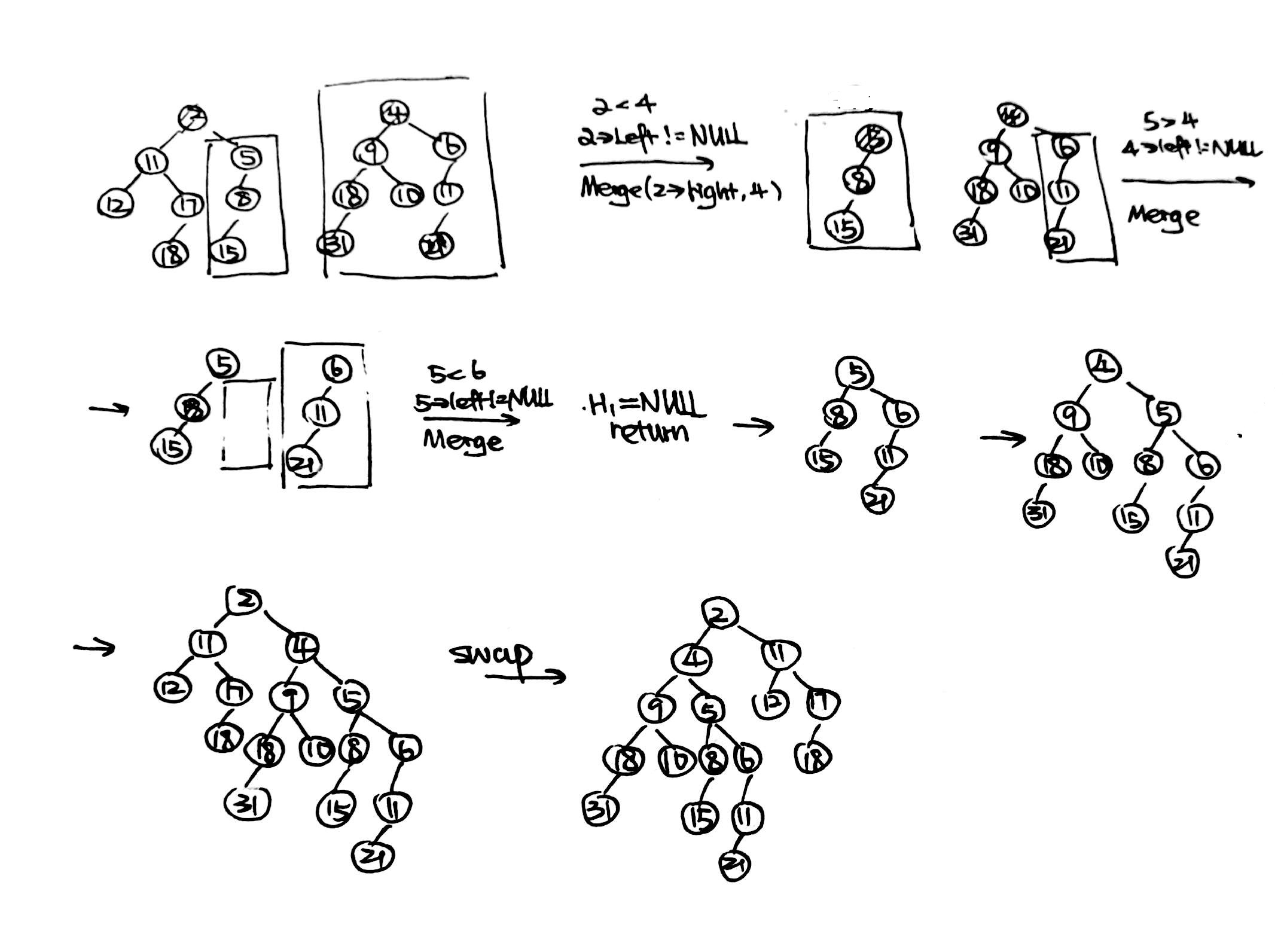Leftist Heaps 习题解
2016-06-02 23:17
417 查看
Leftist Heaps (最左堆)是一种用于快速合并的数据结构,是堆的一种变种。它的合并操作只需花费O(logN)的代价。
对于二叉堆来说,两个堆合并是非常昂贵的操作,这将耗费O(N)的时间,与重新建堆的时间相同。为了应对优先队列的Merge操作,我们从本篇开始将介绍包括最左堆(又叫左式堆)在内的三种数据结构。
本篇将介绍相关题目。
证明 二叉堆的合并需要耗费O(N)的代价
二叉堆合并操作是通过将一个堆的元素依次插入另一个堆完成的。我们知道,堆的插入平均花费常数时间代价。我们考察两个都是N大小的堆的合并,那么我们一共进行N次插入,花费O(N)的代价。

A. 2 is the root with 11 being its right child
B. the depths of 9 and 12 are the same
C. 21 is the deepest node with 11 being its parent
D. the null path length of 4 is less than that of 2

merge操作是这样的:
Merge(MinRoot{T1, T2}, The other tree)
我们记Merge的前一个参数为H1,后一个参数为H2。若H1的左儿子为空,则将H2作为H1左子树。否则合并H1的右子树与H2。
合并后检查是否满足定义,否则交换。
伪代码描述如下:
所以我们按如图方式进行合并,得到最后的那棵树。D选项中4和2的npl都是2。故选D。
[Definition] Npl(X)
The null path length, Npl(X), of any node X is the length of the shortest path from X to a node without two children. Define Npl(NULL) = –1.
也就是说,npl是从该节点到第一个没有两个孩子的子节点的路径长度。
答案为D
We can perform BuildHeap for leftist heaps by considering each element as a one-node leftist heap, placing all these heaps on a queue, and performing the following step: Until only one heap is on the queue, dequeue two heaps, merge them, and enqueue the result. Which one of the following statements is FALSE? (3分)
A. in the k-th run, ⌈N/2k⌉ leftist heaps are formed, each contains 2k nodes
B. the worst case is when N=2K for some integer K
C. the time complexity T(N)=O(N2log20+N22log21+N23log22+...+N2Klog2K−1 for some integer K so that N=2K
D. the worst case time complexity of this algorithm is Θ(NlogN)
这里主要证明D选项是FALSE:
T(N)=O(N2log20+N22log21+N23log22+...+N2Klog2K−1
=O(N2log2×0+N22log2×1+N23log2×2+...+N2Klog2×(K−1)
=N⋅log2⋅(122+223+...+k−12k)
括号内的和我们可以通过错位相减法求出,于是式子化为
=N⋅log2⋅(1−k+12k)
k+12k在N趋近无穷大时为0
故时间复杂度为O(N)
对于二叉堆来说,两个堆合并是非常昂贵的操作,这将耗费O(N)的时间,与重新建堆的时间相同。为了应对优先队列的Merge操作,我们从本篇开始将介绍包括最左堆(又叫左式堆)在内的三种数据结构。
本篇将介绍相关题目。
证明 二叉堆的合并需要耗费O(N)的代价
二叉堆合并操作是通过将一个堆的元素依次插入另一个堆完成的。我们知道,堆的插入平均花费常数时间代价。我们考察两个都是N大小的堆的合并,那么我们一共进行N次插入,花费O(N)的代价。
题目
Merge the two leftist heaps in the following figure. Which one of the following statements is FALSE? (3分)
A. 2 is the root with 11 being its right child
B. the depths of 9 and 12 are the same
C. 21 is the deepest node with 11 being its parent
D. the null path length of 4 is less than that of 2

merge操作是这样的:
Merge(MinRoot{T1, T2}, The other tree)
我们记Merge的前一个参数为H1,后一个参数为H2。若H1的左儿子为空,则将H2作为H1左子树。否则合并H1的右子树与H2。
合并后检查是否满足定义,否则交换。
伪代码描述如下:
PriorityQueue Merge ( PriorityQueue H1, PriorityQueue H2 )
{
if ( H1 == NULL ) return H2;
if ( H2 == NULL ) return H1;
if ( H1->Element < H2->Element ) return Merge1( H1, H2 );
else return Merge1( H2, H1 );
}
static PriorityQueue
Merge1( PriorityQueue H1, PriorityQueue H2 )
{
if ( H1->Left == NULL ) /* single node */
H1->Left = H2; /* H1->Right is already NULL
and H1->Npl is already 0 */
else {
H1->Right = Merge( H1->Right, H2 ); /* Step 1 & 2 */
if ( H1->Left->Npl < H1->Right->Npl )
SwapChildren( H1 ); /* Step 3 */
H1->Npl = H1->Right->Npl + 1;
} /* end else */
return H1;
}所以我们按如图方式进行合并,得到最后的那棵树。D选项中4和2的npl都是2。故选D。
[Definition] Npl(X)
The null path length, Npl(X), of any node X is the length of the shortest path from X to a node without two children. Define Npl(NULL) = –1.
也就是说,npl是从该节点到第一个没有两个孩子的子节点的路径长度。
答案为D
We can perform BuildHeap for leftist heaps by considering each element as a one-node leftist heap, placing all these heaps on a queue, and performing the following step: Until only one heap is on the queue, dequeue two heaps, merge them, and enqueue the result. Which one of the following statements is FALSE? (3分)
A. in the k-th run, ⌈N/2k⌉ leftist heaps are formed, each contains 2k nodes
B. the worst case is when N=2K for some integer K
C. the time complexity T(N)=O(N2log20+N22log21+N23log22+...+N2Klog2K−1 for some integer K so that N=2K
D. the worst case time complexity of this algorithm is Θ(NlogN)
这里主要证明D选项是FALSE:
T(N)=O(N2log20+N22log21+N23log22+...+N2Klog2K−1
=O(N2log2×0+N22log2×1+N23log2×2+...+N2Klog2×(K−1)
=N⋅log2⋅(122+223+...+k−12k)
括号内的和我们可以通过错位相减法求出,于是式子化为
=N⋅log2⋅(1−k+12k)
k+12k在N趋近无穷大时为0
故时间复杂度为O(N)
相关文章推荐
- C#数据结构之顺序表(SeqList)实例详解
- Lua教程(七):数据结构详解
- 解析从源码分析常见的基于Array的数据结构动态扩容机制的详解
- C#数据结构之队列(Quene)实例详解
- C#数据结构揭秘一
- C#数据结构之单链表(LinkList)实例详解
- 数据结构之Treap详解
- 用C语言举例讲解数据结构中的算法复杂度结与顺序表
- C#数据结构之堆栈(Stack)实例详解
- C#数据结构之双向链表(DbLinkList)实例详解
- JavaScript数据结构和算法之图和图算法
- Java数据结构及算法实例:冒泡排序 Bubble Sort
- Java数据结构及算法实例:插入排序 Insertion Sort
- Java数据结构及算法实例:考拉兹猜想 Collatz Conjecture
- java数据结构之java实现栈
- java数据结构之实现双向链表的示例
- Java数据结构及算法实例:选择排序 Selection Sort
- Java数据结构及算法实例:朴素字符匹配 Brute Force
- Java数据结构及算法实例:汉诺塔问题 Hanoi
- Java数据结构及算法实例:快速计算二进制数中1的个数(Fast Bit Counting)
